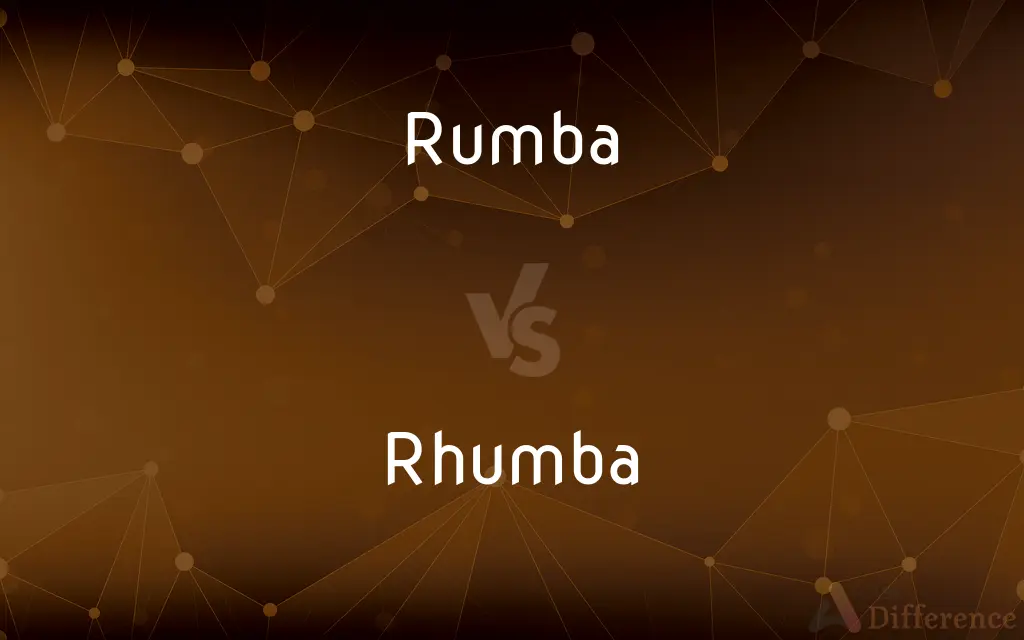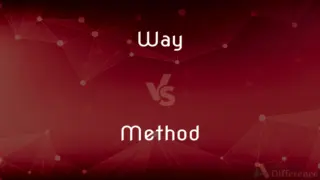Rumba vs. Rhumba — What's the Difference?
Edited by Tayyaba Rehman — By Fiza Rafique — Updated on April 2, 2024
Rumba is a genre of dance and music originating from Cuba, characterized by its complex rhythms and movements, whereas Rhumba is a ballroom dance that evolved from the Cuban Rumba, adapted for competitive dance in the international style.

Difference Between Rumba and Rhumba
Table of Contents
ADVERTISEMENT
Key Differences
Rumba has its roots in African rhythms and Spanish melodies, creating a rich musical tradition that is both expressive and diverse. It's known for its sensual movements, intricate footwork, and dynamic tempo. On the other hand, Rhumba, often seen in ballroom competitions, features slower, more standardized steps, emphasizing smooth, continuous body movements and romantic themes.
The Cuban Rumba encompasses various styles, including the guaguancó, yambú, and columbia, each with distinct rhythms, dances, and cultural significances. It is often performed in social gatherings, reflecting a blend of historical narratives and personal expressions. Whereas Rhumba, as practiced in ballroom settings, focuses on a more refined and elegant interpretation, tailored to meet the criteria of formal dance competitions.
Rumba's music is rich in percussion, using instruments like the clave, congas, and bongos, along with vocals that tell stories or express emotions. This genre emphasizes the polyrhythmic complexity that invites improvisation and interaction between dancers. Rhumba music, while also drawing from Cuban influences, is often orchestrated to suit ballroom acoustics, prioritizing melody and rhythm that guide the dancers' fluid movements.
In Rumba, the dance is a dialogue between the dancers, often mirroring a narrative of attraction and courtship, where movements are spontaneous and responsive to the music's rhythm. In contrast, Rhumba dancers follow a more scripted choreography, where precision, technique, and the portrayal of a romantic story take precedence.
The social and cultural context of Rumba allows for a more communal and interactive experience, with participants and observers often blurring the lines through their engagement. Rhumba, however, is typically performed for an audience or judges, where the emphasis is on presentation, skill, and adherence to standardized dance figures.
ADVERTISEMENT
Comparison Chart
Origin
Cuba
Evolved from Cuban Rumba in the West
Music Characteristics
Complex rhythms, percussion-heavy
Melodic, orchestrated for ballroom
Dance Style
Expressive, improvisational
Smooth, standardized steps
Cultural Significance
Reflects Cuban history and social narratives
Competitive, focused on technique and presentation
Typical Venue
Social gatherings, informal settings
Ballroom competitions, formal events
Compare with Definitions
Rumba
Known for styles like guaguancó, yambú, and columbia.
The dancers showcased the guaguancó style of Rumba.
Rhumba
Focused on precision and presentation.
The dancers practiced their Rhumba technique diligently.
Rumba
A genre of Cuban music characterized by percussion and polyrhythms.
The band's Rumba rhythms got everyone on their feet.
Rhumba
Adapted for competitive ballroom dancing.
They won the championship with their stunning Rhumba performance.
Rumba
Reflects a blend of Spanish melodies and African rhythms.
Rumba's rich history was evident in its music.
Rhumba
A ballroom dance derived from the Cuban Rumba.
The couple's Rhumba was flawless in the competition.
Rumba
A Cuban dance emphasizing complex rhythms and expressive movements.
They danced the Rumba with passion and energy.
Rhumba
Characterized by smooth, romantic movements.
Their Rhumba movements were elegant and refined.
Rumba
A dance of narrative and interaction.
Their Rumba performance told a captivating story.
Rhumba
Features orchestrated music suitable for ballrooms.
The orchestra played a beautiful Rhumba melody.
Rumba
The term rumba may refer to a variety of unrelated music styles. Originally, "rumba" was used as a synonym for "party" in northern Cuba, and by the late 19th century it was used to denote the complex of secular music styles known as Cuban rumba.
Rhumba
Rhumba, also known as ballroom rumba, is a genre of ballroom music and dance that appeared in the East Coast of the United States during the 1930s. It combined American big band music with Afro-Cuban rhythms, primarily the son cubano, but also conga and rumba.
Rumba
A rhythmic dance with Spanish and African elements, originating in Cuba
To see an authentic rumba you must go to Havana
Rhumba
Variant of rumba.
Rumba
Dance the rumba
You once taught two boys to rumba
Rhumba
Alternative spelling of rumba
Rumba
A dance of Cuban origin, combining complex footwork with a pronounced movement of the hips.
Rhumba
Alternative spelling of rumba
Rumba
A modern ballroom adaptation of this dance.
Rhumba
Syncopated music in duple time for dancing the rumba
Rumba
The music for either of these dances.
Rhumba
Dance the rhumba
Rumba
A slow-paced Cuban partner dance in 4:4 time.
Rumba
To dance the rumba.
Rumba
Syncopated music in duple time for dancing the rumba
Rumba
A rhythmic syncopated Cuban folk dance in duple time
Rumba
A ballroom dance based on the Cuban folk dance
Common Curiosities
Is Rumba a social dance?
Yes, Rumba originated as a social dance in Cuba, reflecting the country's cultural and historical narratives, often performed in communal settings.
Can Rumba and Rhumba music be used interchangeably?
Not typically, as Rumba music is percussion-heavy and complex, suited for expressive dance, while Rhumba music is orchestrated for ballroom dancing with a smoother flow.
What is the main difference between Rumba and Rhumba?
Rumba is a Cuban dance and music genre known for its expressive and complex rhythms, while Rhumba is a ballroom dance adapted from the Cuban Rumba with more standardized and smooth movements.
Why is Rhumba often seen in ballroom competitions?
Rhumba has been adapted for the competitive ballroom scene, emphasizing technique, precision, and presentation, which are key criteria in dance competitions.
How do the cultural origins of Rumba influence its dance style?
Rumba's dance style is deeply influenced by its Cuban origins, incorporating elements of African rhythms and Spanish melodies, which emphasize expressive and narrative movements.
Are the steps in Rumba and Rhumba the same?
No, Rumba steps are more improvisational and expressive, reflecting a dialogue between dancers, while Rhumba steps are standardized, focusing on smooth, continuous body movements.
Why is Rhumba considered a romantic dance?
Rhumba is considered romantic due to its slow, smooth movements and the close connection between partners, often portraying love stories through dance.
What instruments are typical in Rumba music?
Instruments like claves, congas, and bongos are typical in Rumba, creating its distinctive polyrhythmic sound.
Can beginners learn Rhumba easily?
Yes, with its standardized steps and slower pace, Rhumba can be accessible to beginners, especially in a structured learning environment like ballroom dance classes.
What makes Rhumba popular in ballroom dancing?
Rhumba's popularity in ballroom dancing comes from its elegant and romantic style, which is well-suited for formal competitions and events, appealing to dancers and audiences alike.
How do the tempos of Rumba and Rhumba compare?
Rumba can vary in tempo depending on the style, but it generally features dynamic and fast-paced rhythms, while Rhumba is danced to a slower, more controlled tempo.
What role does storytelling play in Rumba?
Storytelling is a significant aspect of Rumba, with the dance often reflecting narratives of courtship, passion, and community, expressed through its movements and rhythms.
Do Rumba and Rhumba require a partner?
Yes, both dances are typically performed with a partner, emphasizing the interaction and connection between dancers.
Is there a specific attire for dancing Rumba or Rhumba?
While Rumba can be danced in various outfits reflecting its informal and expressive nature, Rhumba dancers often wear formal ballroom attire to match the elegance and precision of the dance.
Can Rumba be performed competitively?
While traditionally a social dance, Rumba can also be performed in dance competitions, especially in categories focusing on Latin dances.
Share Your Discovery

Previous Comparison
Sage vs. Sagebrush
Next Comparison
Way vs. MethodAuthor Spotlight
Written by
Fiza RafiqueFiza Rafique is a skilled content writer at AskDifference.com, where she meticulously refines and enhances written pieces. Drawing from her vast editorial expertise, Fiza ensures clarity, accuracy, and precision in every article. Passionate about language, she continually seeks to elevate the quality of content for readers worldwide.
Edited by
Tayyaba RehmanTayyaba Rehman is a distinguished writer, currently serving as a primary contributor to askdifference.com. As a researcher in semantics and etymology, Tayyaba's passion for the complexity of languages and their distinctions has found a perfect home on the platform. Tayyaba delves into the intricacies of language, distinguishing between commonly confused words and phrases, thereby providing clarity for readers worldwide.
















































